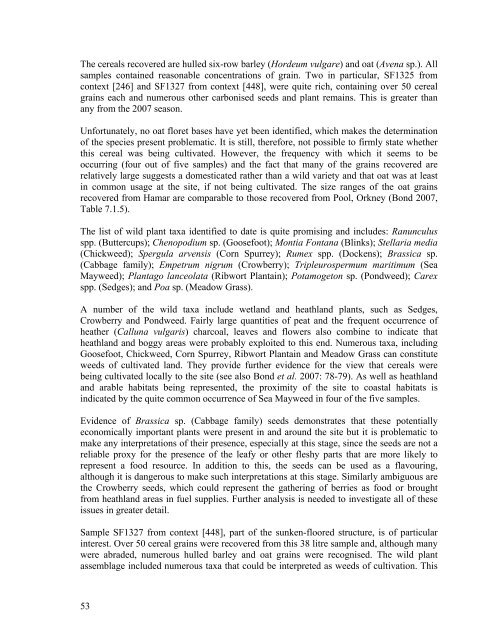VIKING UNST PROJECT: FIELD SEASON 2008 - Nabo
VIKING UNST PROJECT: FIELD SEASON 2008 - Nabo
VIKING UNST PROJECT: FIELD SEASON 2008 - Nabo
- No tags were found...
You also want an ePaper? Increase the reach of your titles
YUMPU automatically turns print PDFs into web optimized ePapers that Google loves.
The cereals recovered are hulled six-row barley (Hordeum vulgare) and oat (Avena sp.). Allsamples contained reasonable concentrations of grain. Two in particular, SF1325 fromcontext [246] and SF1327 from context [448], were quite rich, containing over 50 cerealgrains each and numerous other carbonised seeds and plant remains. This is greater thanany from the 2007 season.Unfortunately, no oat floret bases have yet been identified, which makes the determinationof the species present problematic. It is still, therefore, not possible to firmly state whetherthis cereal was being cultivated. However, the frequency with which it seems to beoccurring (four out of five samples) and the fact that many of the grains recovered arerelatively large suggests a domesticated rather than a wild variety and that oat was at leastin common usage at the site, if not being cultivated. The size ranges of the oat grainsrecovered from Hamar are comparable to those recovered from Pool, Orkney (Bond 2007,Table 7.1.5).The list of wild plant taxa identified to date is quite promising and includes: Ranunculusspp. (Buttercups); Chenopodium sp. (Goosefoot); Montia Fontana (Blinks); Stellaria media(Chickweed); Spergula arvensis (Corn Spurrey); Rumex spp. (Dockens); Brassica sp.(Cabbage family); Empetrum nigrum (Crowberry); Tripleurospermum maritimum (SeaMayweed); Plantago lanceolata (Ribwort Plantain); Potamogeton sp. (Pondweed); Carexspp. (Sedges); and Poa sp. (Meadow Grass).A number of the wild taxa include wetland and heathland plants, such as Sedges,Crowberry and Pondweed. Fairly large quantities of peat and the frequent occurrence ofheather (Calluna vulgaris) charcoal, leaves and flowers also combine to indicate thatheathland and boggy areas were probably exploited to this end. Numerous taxa, includingGoosefoot, Chickweed, Corn Spurrey, Ribwort Plantain and Meadow Grass can constituteweeds of cultivated land. They provide further evidence for the view that cereals werebeing cultivated locally to the site (see also Bond et al. 2007: 78-79). As well as heathlandand arable habitats being represented, the proximity of the site to coastal habitats isindicated by the quite common occurrence of Sea Mayweed in four of the five samples.Evidence of Brassica sp. (Cabbage family) seeds demonstrates that these potentiallyeconomically important plants were present in and around the site but it is problematic tomake any interpretations of their presence, especially at this stage, since the seeds are not areliable proxy for the presence of the leafy or other fleshy parts that are more likely torepresent a food resource. In addition to this, the seeds can be used as a flavouring,although it is dangerous to make such interpretations at this stage. Similarly ambiguous arethe Crowberry seeds, which could represent the gathering of berries as food or broughtfrom heathland areas in fuel supplies. Further analysis is needed to investigate all of theseissues in greater detail.Sample SF1327 from context [448], part of the sunken-floored structure, is of particularinterest. Over 50 cereal grains were recovered from this 38 litre sample and, although manywere abraded, numerous hulled barley and oat grains were recognised. The wild plantassemblage included numerous taxa that could be interpreted as weeds of cultivation. This53
















